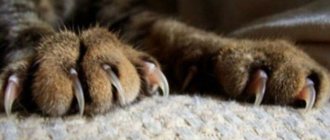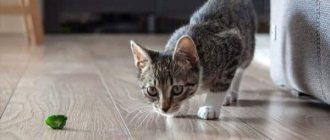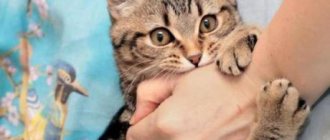Often, upon reaching a certain age, a kitten begins to sharpen its claws on surrounding objects, which leads to their gradual deterioration. There are many methods for stopping a cat from scratching a sofa, favorite chair, ottomans or cabinet doors. The main thing is not to try to explain to the animal that this cannot be done. The options advertised by many involving spraying the cat with water or shouting loudly will not help protect the furniture. They will only provoke aggression on the part of the kitten, who, at best, will begin to scratch something else, but no less valuable.
You should immediately take into account that the animal will not stop sharpening its claws; this is a natural process that has a positive effect on the physical and mental state of the pet. On the one hand, the cat marks its territory in this way, establishing itself as a full-fledged resident of the apartment. Often cats deliberately tear at the owner’s favorite place, thereby showing their location. And in some cases, this is the only way to improve the condition of worn-out claws.
Why do cats have a passion for upholstered furniture?
Before you figure out how to stop a cat from tearing up furniture, you need to justify this behavior of your pet to yourself. The animal is partial to upholstered furniture and wallpaper because:
- Follows instincts. Claws are the main defense of cats in the wild. To hunt and survive, they need to hone their claw skills. Now Barsik no longer obtains his own food, but thousands of years of evolution are not easily forgotten.
- Sharpening his claws. People file their nails with a nail file, dogs sharpen their claws while running on a hard surface, and in order for a cat to get their claws in order, they need to stick them as deeply as possible into the hard surface and drag them across it with force. Dead claw scales remain on the upholstery, and new ones form in their place.
- Stretching. You've probably noticed how the purr elegantly arches its back and stretches. At this time, he likes to move his paws, ruining the upholstery.
- Relieves tension. Sometimes a cat kills the sofa upholstery very carefully. She takes out aggression in this way when she is angry or upset.
- Marks territory. Cats have scent pads at the base of their paws. While scratching, the pet marks the object with its individual scent.
When we have decided that it is vital for a fluffy to sharpen its claws, we should consider how to wean a cat from tearing furniture and wallpaper.
Is there wallpaper that cannot be removed?
Before purchasing a kitten, are you thinking about the need to put up special wallpaper in your house that will not be scratched by cats? You will be disappointed when you find out that there are no such finishing materials that completely eliminate damage.
Experienced cat lovers are not only experts in the field of felinology, but can also tell you which wallpaper cats hardly scratch or their efforts are not particularly noticeable:
- Vinyl is the most affordable wallpaper. The stores have the largest assortment of them; you can easily select rolls to suit your taste and interior. The advantage is that they can be washed with detergents.
- For painting - you can repeatedly repaint either the entire surface or individual fragments that have been damaged.
- Liquid - a smooth surface without a pronounced pattern does not allow claws to catch on the surface.
- Fiberglass ones not only look impressive, but are also the most durable and fairly easy to clean.
The walls in residential premises are in most cases decorated with wallpaper, but maybe you are interested in decorative panels made of plastic, chipboard, MDF, granite or artificial stone? This type of finish is particularly durable and easy to maintain; if necessary, some panels can be easily replaced by others.
Scratching posts
There are many ways to stop a cat from tearing up wallpaper and furniture. The most popular of them is the scratching post
- a special item for scratching claws. They can be horizontal and vertical, floor and wall, in the form of planks and columns. They are united by a soft surface - it is sheathed with thick fabric or wrapped with thick rope.
The easiest way is to accustom a kitten to a scratching post. Place it in a visible place, bring the baby and run your paws over its surface several times. Every time the purr uses an object for its intended purpose, praise it and give it a treat.
In order not to think about how to stop a cat from scratching wallpaper, place the scratching post in a walk-through place: near the sleeping bed, in the play area, next to the sofa. You should purchase several scratching posts for a large apartment.
Basic rules for behavior correction
- Avoid physical punishment . Cats cannot establish a cause-and-effect relationship between punishment and their behavior, and begin to treat their owner with distrust.
- Give your pet more time . This will help relieve the psyche and relieve stress that pushes the animal into unwanted behavior.
- Try different types of scratching posts . Don't limit yourself to one design. Moreover, when one of them fails, do not rush to throw it away. Place the new one next to the old one so that the animal has a choice. Then the transition will not be so abrupt.
- Be careful with the negative association method . If an animal pulls things out due to prolonged stress, the situation can only get worse.
- Be consistent . Patiently repeat the same exercise several times a day. If you avoid violence and aggression, the animal will listen to you.
Anti-scratch
These are special caps for claws made of vinyl. Using glue, they are attached to the cat’s claws, allowing him to express himself without spoiling the interior.
How to stop a cat from tearing up furniture? the anti-scratch pads one by one using glue.
. Every 10-14 days the caps will fall off and need to be re-glued.
At first the animal will try to get rid of the “manicure”, but will soon get used to it. Anti-scratch guards are available on the market in different sizes depending on the length of your pet’s claws (S, M, L). It is advisable to purchase several sizes at once.
What to do if a cat scratches a leather sofa?
If time has been lost and the cat has thoroughly torn up the furniture upholstered in fabric, restoring a specific area using the same material or an original decorative insert can help. A leather sofa cannot be restored so easily; you can only mask shallow scratches on your own. In case of serious damage, it is better not to try to do anything at home, but to immediately contact a professional.
- Olive oil. The use of this component can save, even if the animal prefers to sharpen its claws on light skin. It is first recommended to test the method on an inconspicuous area of the material and only then begin restoration. Take slightly warm olive oil and a thick cotton pad. We soak the cotton wool in the oil, squeeze it out thoroughly, and gently wipe the scratch itself and small areas of skin around it. We work in a circular motion in one direction. After this, we wait until the composition dries and evaluate the work. In some cases, a scratch may disappear without leaving a trace after just one treatment. If necessary, repeat the manipulation.
- If a cat slightly scratches a dark leather sofa, it is better to use shoe polish. We select the product of the required shade, apply it to a cotton swab and carefully rub it into the damaged surface. We wait until the mixture dries and wipe the area with a clean paper napkin. We evaluate the work and, if necessary, make several more approaches.
- If the furniture is covered with deep scratches, you will have to do the following. We use the oil approach first (regardless of the color of the material). Then we treat the area with oil again, put a cotton cloth on it and wait for the liquid to be absorbed into it. After this, we take a new piece of fabric, moisten it with water and apply it to the damaged area. Iron the flap with a warm iron, holding it for no more than 8-10 seconds. If necessary, repeat several times. From this effect, the oil will be absorbed better, masking the scratches.
The sooner you start implementing the above methods, the greater the chances of saving the furniture without sacrificing the health and good mood of your pet.
We recommend reading the article on how to stop a cat from scratching wallpaper
Important points
When purchasing a scratching post, add a few drops of valerian or motherwort to it (they attract cats). The scratching post should:
- match the pet’s height;
- be securely fastened and withstand pressure from the animal;
- be of medium degree of hardness and roughness.
When choosing a spray, make sure that it does not cause an allergy in your purr. It is best to have your nails trimmed by a veterinarian at first. If you trim the nail too much, you can damage nearby blood vessels, cause an infection, or at least cause pain to your pet.
If you don’t know how to stop a cat from scratching furniture, don’t forget to use traditional methods:
- say “no” or “no” sharply and loudly;
- lightly spray your pet with water from a spray bottle (this will not harm, but it will be unpleasant for the animal).
How to stop a cat from scratching furniture and wallpaper? Use scents. Felines do not like the smell of citrus fruits, onions and vinegar. Dilute citrus oil with water and spray the liquid onto the damaged areas.
What not to do
One cannot be inconsistent in weaning an animal from a bad habit. This means that it is useless to scold the cat once for a mistake, and a second time to ignore it. Every crime noticed must be punished.
- You cannot hit a cat; you can scare it with a slap of a towel or rolled up paper. The animal will not experience pain, but will feel the effect of surprise - as in the case of a loud shout or the ringing of a rattle.
- An animal cannot be punished by being locked in a room, left without food or drink - it will definitely not understand why such harsh methods were applied to it, and will only suffer. Particularly sensitive people may become ill due to a bad attitude.
- And of course, in no case should you wean your cat from damaging furniture or wallpaper if there is no place in the house specially equipped for these matters. A cat will not be able to avoid sharpening its claws at all: this is the same need as eating, drinking, sleeping and relieving itself. Therefore, scolding a cat before purchasing or creating a scratching post is pointless.
Cover furniture with covers or tape
Instead of swearing at your pussy, block access to her favorite scratching spots. The easiest and most effective way to do this is to cover these areas with double-sided tape . Cats don't like to touch sticky surfaces, so your cat will stop trying to sharpen her claws in that area.
If you have already provided her with enough quality scratching posts that she uses, she will quickly forget that furniture can also sharpen her claws. After this you can remove the tape.
If you do not want to use tape, you can cover the furniture with a special cover.
Limiting your pet's access to things
Hiding damaged areas of furniture
Some elements of an apartment's interior, such as leather furniture, are very attractive to cats, so it is recommended to stick double-sided tape, masking tape with the sticky side up, or special sticky strips on it (sticky surfaces are unpleasant for cats).
Cover furniture with plastic sheeting or rugs. Cats find this texture unpleasant.
You can use protective covers that are easy to wash and clean.
Vandal-proof sofa cover
We close the doors where the pet’s favorite furniture is located.
It's not difficult to keep the door closed and keep pets out of valuable furniture. If a cat sneaks in, make a sharp, loud noise so that it gets scared and runs away.
Do not remove claws
Whatever you do, please never declaw your purr. This is an extremely painful procedure that involves amputating part of your cat's toes. In many countries this procedure is illegal. And even if it is still legal where you live, it is cruel and should not be used.
We hope that this article will help you in training your pet to use a scratching post. Please share this article so other cat owners can learn about humane and effective ways to deal with the problem. If you have your own methods that you would like to share, we will be happy to read about them in the comments! Thank you!
Sources:
https://nashakoshka.ru/vospitanie-koshki/kak-otuchit-kota-drat-mebel.html https://zen.yandex.ru/media/id/5cdc7729e4fed200b2da69cb/5d67d27205fd9800ae1dec1d https://kotochek.ru/povedenie/ kak-otuchit-koshku-drat-mebel/
We use a spray bottle
If your cat has learned to perform manicure procedures using upholstered furniture, experts recommend teaching the cat a lesson using a spray bottle of clean water. As you know, representatives of the feline family fear water procedures, so a stream of refreshing water will quickly discourage the desire to scratch the furniture in the house.
- works effectively after several water procedures;
- does not require additional costs, clean water is always available to people.
- the method works only during the period of time spent together in the room;
- being unattended by the owner, the cat will happily continue the work it has begun.











